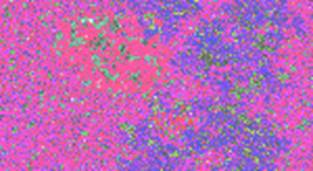
|

|
|
In this section of my research, I have collaborated to various
artificial life studies, which focused on the level of large
populations of individuals and examined their collective evolution.
Although there are no "morphogenetic engineering" concerns per se,
individuals are still internally sophisticated, as they can
contain a long genomic sequence, an intricate genetic program, or a
set of generative (rewrite) rules giving rise to complex morphologies.
|
|
|
|
A spatially explicit model of endogenous speciation in the absence
of environmental constraints
|
 |
A commonly held view in evolutionary biology is that speciation,
i.e., the emergence of genetically distinct and reproductively
incompatible subpopulations, is driven by the external environment.
Guy Hoelzer, Rich Drewes and myself have developed a
spatially explicit model of a biological population to study the
emergence of spatial and temporal patterns of genetic diversity in
the absence of such constraints.
|
|
Speciation is usually thought to be either caused by geographical
boundaries ("allopatric" speciation from mountains, rivers, islands,
etc.; Fig. a, left) or pre-existing environmental
inhomogeneities ("parapatric" or "sympatric" speciation from
unequal climate or resource distribution; Fig. a, right).
|
|
|
|
A model of spatial population dynamics combining L-systems, genetic
expression, biologically inspired mutations, and open-ended evolution
|
 |
This part of José David Fernández's PhD, which I co-directed with
his main advisor Francisco Vico,
examines the formation, evolution, and diversity dynamics of
a community of virtual plants through a new
individual-centered model at multiple scales:
genetic, developmental, and physiological. It is
an original attempt to combine development, evolution, and
population dynamics (from multi-agent interactions) into one
comprehensive, yet simple model.
|
|
Understanding the dynamics of biodiversity has
become an important line of research in theoretical ecology and,
in particular, conservation biology. However, studying the evolution
of ecological communities under traditional modeling approaches
based on differential calculus requires species' characteristics to be
predefined, which limits the generality of the results.
|
|
|
|
Exploring a new class of cellular automata capable of longterm phenotypic
dynamics, including a high level of variance and behavioral diversity.
|
 |
In this original work by my MSc student David Medernach, co-supervised by Taras Kowaliw, we study open-ended evolution by analyzing
heterogeneous cellular automata (HetCA). The model involves cells that have
an "age", "decay", and "quiescence", a transition function based on genetic
programming, and transfer between adjacent cells. These changes convert
a CA system into a new kind of "ecosystem", where different genomes
compete for existence.
|
|
A major motivation for work in artificial life is to create
open-ended evolution, or systems in which novel artifacts are
continuously produced. The best known example is Ray's Tierra
world, where there is competition between replicating computer
programs in a virtual machine. Later, another evolutionary
system by Adami, called Avida, became popular and was extended
in many directions. High-level systems exist as well, where agents
execute complex predefined functions, such as eating or fighting
in Yaeger's Polyworld.
|
|













